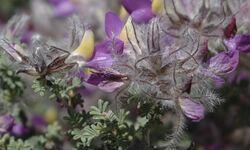Biology:Dalea formosa
From HandWiki
Short description: Species of plant
| Dalea formosa | |
|---|---|

| |
| Scientific classification | |
| Kingdom: | Plantae |
| Clade: | Tracheophytes |
| Clade: | Angiosperms |
| Clade: | Eudicots |
| Clade: | Rosids |
| Order: | Fabales |
| Family: | Fabaceae |
| Subfamily: | Faboideae |
| Genus: | Dalea |
| Species: | D. formosa
|
| Binomial name | |
| Dalea formosa Torr.
| |
Dalea formosa is a species of flowering plant in the genus Dalea, known by the common names feather dalea and featherplume;[1] it is named for the physician Samuel Dale.[2] The plant is native to the southern United States.[2] It is highly tolerant of heat, cold, and drought.[3][4] It is favored by honeybees; but of much less use to most wildlife, with the exception of rabbits and deer.[5][6] Unique to most plants,[Note 1] it blooms all year long (with the occurrence of monsoon rainfall)[7][8] and also has a long lifespan.[4]
References
- ↑ Southwest, The American. "Western USA wildflowers: Feather Peabush, Dalea Formosa". https://www.americansouthwest.net/plants/wildflowers/dalea-formosa.html.
- ↑ 2.0 2.1 "SEINet Portal Network - Dalea formosa". https://swbiodiversity.org/seinet/taxa/index.php?tid=1546.
- ↑ "Dalea formosa". https://www.wildflower.org/plants/result.php?id_plant=dafo.
- ↑ 4.0 4.1 "USDA Plants Database". https://plants.usda.gov/home/plantProfile?symbol=DAFO.
- ↑ "Plants of Texas Rangelands » Feather Dalea". https://rangeplants.tamu.edu/plant/feather-dalea/.
- ↑ Xerces Society. Native plants for pollinators and beneficial insects: Southwest - Sonoran Desert Retrieved July 27, 2023
- ↑ "Blue Wildflowers - Big Bend National Park (U.S. National Park Service)". https://www.nps.gov/bibe/learn/nature/blue-wildflowers.htm.
- ↑ "Dalea formosa, Indigobush, Southwest Desert Flora". http://southwestdesertflora.com/WebsiteFolders/All_Species/Fabaceae/Dalea%20formosa,%20Indigobush.html.
Explanatory notes
- ↑ Generally, plants expend considerable energy to bloom and that decreases their lifespan or the duration of their bloom, or both; especially in hot regions. Blooming flowers expend considerable energy through nectar production, water loss via transpiration, and respiration of flower parts (Schoen & Ashman, 1994). “Interestingly, flower lifespan is negatively correlated with temperature; the hotter the environment where they bloom, the shorter the period a plant retains them. The phenomenon has been known for a long time,” comments Shoko Sakai, author of the present study.
Wikidata ☰ Q3012330 entry
 |

